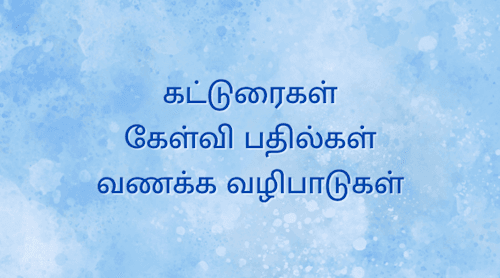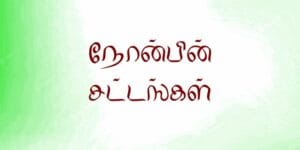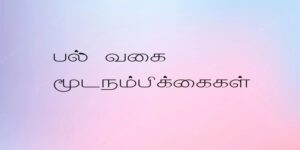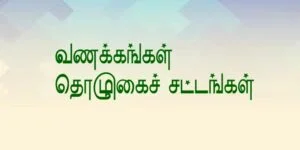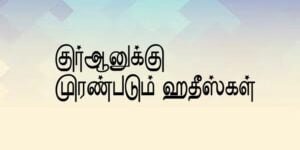The history of the compilation of Quran in the mind of the prophet (pbuh)
In the preface, we have already explained, how the Holy Quran was revealed to the prophet (pbuh). We will analyze his Quran was compiled and protected.
The prophet (pbuh) would record in his mind whatever is revealed by God.
The prophet (pbuh), was advised by God not to take extra care to memorize the verses of the Quran. God promised him that it was his responsibility to record the Quranic verses into mind of the prophet (pbuh). (Quran 75:16-19, 20:114)
The Quran states, “Do not try to memorize by reciting again and again. It is our responsibility to record it in your mind.” (….)
In another verse God gave a promise, by stating, “I will recite it to you. You will not forget it.” (87:6)
So even when Gibrael (alai) recited more number of verses they were recorded in the mind of the prophet (pbuh) like a recording in a tape-recorder.
It was a special privilege given to the prophet (pbuh), so nobody can say that the prophet (pbuh) would have forgotten to remember any one of the messages revealed by God. Thus, the Quran was protected by God in the mind of the prophet (pbuh)
In the minds of the companions of the prophet (pbuh)
Though the people during the period of the prophet (pbuh) remained illiterate, they possessed phenomenal memory power. Usually, we can observe that the illiterate people possess very good memory power. It is because they can survive only if they remember. So, the compulsion on them to remember things activates their memory power.
Thus the companions of the prophet (pbuh), even though they remained illiterate, memorized whatever is conveyed to them by the prophet (pbuh).
If the Quran had been revealed either totally or in a short period they would have found it very difficult to remember
As the Quran has been revealed gradually during a period of 23 years, it would have been easier to memorize it. If you had memorized daily a verse then you would have had sufficient time to memorize the whole Quran.
The prophet (pbuh) has also made an arrangement, which helped the Muslims to retain the Quran in their memory. That is, it was made obligatory for every Muslim to recite at least certain verses of Quran in their five times prayer and other optional prayers.
This procedure helped even those who have not memorized the Quran to remember it.
The prophet (pbuh) took care to convey the Quran among other people. He sent many companions of the prophet (pbuh) to the people who have newly embraced Islam for teaching them Quran. This action was also beneficial to protect the Quran with the minds.
Moreover, once a year, Gibrael (alai) would come to the prophet remind him the verses revealed and put them in a serial order.
The year when the prophet (pbuh) died, Gibrael visited the prophet (pbuh) twice to perform the above act. It is recorded in the authentic collection of hadith (Bukhari 6, 1902, 3220, 3554, 4998)
Thus the Quran has been protected in the minds of the people. A large number of the companions of the prophet (pbuh) had memorized it.
The prominent among them were Abu Bakr, Omar, Osman, Ali, Talha, Saad, Ibn Masood, Hudhaifa, Pbuhim, Abu Huraira, Ibn Umar, Ibn Abbas, Amr Bin Aas, Abdullah Bin Amr, Muawia, Abdullah Bin Zubair, Abdullah Bin Saib, Ayisha, Hafza, Umm Pbuhama, Ubai bin Kaab, Muaad bin Jabal, Zaid Bin Thabit, Abu Dharda, Majma Bin Harissa, Anas Bin Malik (Rasi Allahu Anhum).
Some of the above have memorized the Quran even during the time of the prophet (pbuh), himself and the remaining memorized it later.
The Quranic verse 29:49, also states that the Quran was protected in the minds of the scholars
In the written form
In addition to making arrangements to protect the Quran in the minds of the educationists, the prophets would make the scribes among his companions to write down whatever revelation sent by God.
The prominent among the scribes who recorded the revelations was Abu Bakr, Omar, Osman, Ali, Muawiya, Abam Bin Sayeed, Khalid Bin Waleed, Ubai Bin Kaab, Zaid Bin Tabid, Tabid Bin Khams (Rasiallahu Anhum).
Those companions of the prophet (pbuh), recorded the revelations uttered by the prophet (pbuh) in the barks of a date palm, in the white stone slates, in the skins and the bones with broad width of the animals.
All the recorded materials have been kept in the house of the prophet (pbuh). Those who had memorized the Quran also wrote down the verses and kept them in their possession.
Thus, the revelation of Quran during the period of the prophet (pbuh) had been preserved in the minds of the companions of the prophet and in the recorded materials. This arrangement was made by the prophet (pbuh) himself.
As in many verses of the Quran revealed to the prophet(pbuh), the Quran is addressed as Kitab(Book), in this verse it is mentioned as Suhuf(sheets).
When they are in separate sheets, they are also called Suhufs(sheets) and when they are serialized and compiled together, it is known as Kitab (Book).
Till the days of the prophet (pbuh), Quran was only in the form of suhuf(sheets) and later it was compiled as one Book.
The above verse 98:2, is a proof that even though the Quran was written completely and was set in serial order; as regards the chapters, they had not been placed in serial order.
As Allah knows it that Quran will be compiled totally in serial order, it has been named Kitab (Book)
It is stated in the Quranic verse 98:2 that the prophet would recite from the pure sheets. It should not be misunderstood that the prophet(pbuh) had recited by seeing, as it was mentioned that the prophet used to recite the Suhuf(sheets) and Kitab(Book).
During the rule of Abu Bakr (RA)
Abu Bakr (RA) became the first Khalifa after the death of the prophet (pbuh). During that period, twelve years after hijri, the battle of Yamama was waged.
Musailama an imposter, who claimed prophethood, declared himself on the prophet and he had some followers also. In the war waged between Musailama and the Muslims approxiamately seventy companions of the prophet (pbuh) were killed.
After this incident Umar (RA) met Abu Bakr (RA) and emphasized on the need of ordering the Quran in the written form. Initially, Abu Bakr (Ra)a was reluctant to accept the prophet(pbuh) made by Omar (RA).
He was hesitant because he had not wanted to do a work which was not done by the prophet (pbuh). Later, when Omar (RA) had placed certain valid argument regarding the necessity of producing a written form of a Quran, Abu Bakr (RA) also realized the need and accepted the argument of Omar (RA).
The work of producing the written form of the Quran was entrusted to Zaid Ibn Tabith, the young companion of the prophet (pbuh) who excelled others in memorizing and recording the Quran.
It is recorded in Bukhari 4988, 4989, that he also accepted this and performed his work.
After the revelation of the Quranic verses the prophet (pbuh) would command his companions, who memorized and recorded the verses regarding the placement of the verses in a particular order. In the same order the companions of the prophet (pbuh) would also memorize and record them (Refer Tirmidhi 3011).
The copies of Quran we use now retain the same order of placement of the verses in every chapter as directed by the prophet (pbuh).
The serial order of the verses and the details of the verses to be placed in the chapter was decided only according to the order of the prophet (pbuh).
Then a doubt may arise regarding the role of Abu Bakr (RA) in this. When the message had been revealed all the scribes would not be always present at Madina. Those who had been away from Madina, when the verses were revealed could not have recorded the verses revealed in their absence.
So, it was possible that verses would have been left unrecorded by each scribe.
If everyone had wrongly assumed whatever verses available with him was the complete Quran their contradictions could have been found in Quran.
If all the recorded copies of Quran from all the scribes and from those who have recorded from their memory has been collected together and verified in the presence of all, then the verses which have been left unrecorded will be easily identified.
Abu Bakr performed only this work by entrusting the work to Zaid bin Thabit, the companion of prophet (pbuh).
The preserved original manuscript of the Quran was kept in the possession of Abu Bakr (RA) and after the death of Umar (RA) it was in the possession of Hafsa (RA), who was daughter of Omar (RA) and wife of prophet (pbuh).
Any number of copies could be prepared from the original even after the death of all those who have memorized the Quran.
The rule of Osman (RA)
AS the Quran in its original could not reach the general public the same fear about which, Abu Bakr (RA) and Umar (RA) had been afraid, began appearing during the period of Osman (RA).
The companions of the prophet, who memorized Quran, decreased in number considerably, when Islam spread to different places. There remained the danger that the partially introduced Quran by those who memorize the Quran partially could be considered as the complete Quran. When Osman (RA) learnt this danger, he immediately started the work of producing a number of copies of Quran which would reach different places where Islam has been spread, thereby removing the confusion caused by the partial introduction of the Quran.
Alignment of Chapter
Even-though Abu Bakr (RA) prepared the original recorded manuscript of the Quran, there was no proper alignment of the chapters of Quran in a serial order. Osman (RA) undertook this project of producing copies of Quran by getting the original recorded manuscript form Hafsa (RA)
For example, if you place 50 articles separately in a box we cannot know which article should be numbered first. If they are kept in a serial order, the numbering is easier.
It is wrong to assume that the prophet (Pbuh) had order the alignment of the chapters in the present form. It is only Osman (RA) who had arranged in the present order.
A person from Iraq came to Ayisha (RA) and demanded her to show the manuscript of the Quran. When Ayisha (RA) asked for the reason, he replied. “To arrange the chapters of Quran in correct order.” In reply to that she said, “whatever you recite before (or after) there will not be any harm to you due to that” (Bukhari 4993).
“The prophet (pbuh) recited in his night prayer, (1st) the chapter Al-Baqara (2nd chapter) and then the chapter Alu-Imran(3rd chapter) ”(Muslim, 1291).
Osman (RA) after having a lot of discussions and deliberations with the important companions of the prophet(pbuh), who lived at that time, placed ‘Al-Fatiha’ chapter as the first chapter of Quran, compiled by him, because ‘Al-Fatiha’ chapter was repeated in every ’Rakat’ of the prayer and it was also a chapter which had been praised greatly. Prophet(pbuh) has not mentioned that it should be placed first.
Then, based on the length of the chapters, he put them in a serial order, placing the big chapters in the beginning and the small chapters in the end.
In a few places, due to certain other reasons, he placed the small chapters first and the big chapters later. Even though, the reasons have not been given, there was no doubt that it was only osman (ra) who placed them in a serial order.
INSERT LAPTOP QURAN INDEX
The entire Muslim world unanimously agreed with the arrangement made by Osman (RA) in order to avoid confusion.
We should remember that this alignment of the chapter of Quran was not made either according to the order of God or according to the guidance of the prophet (pbuh).
Ali (RA), kept a manuscript of the Quran, which he personally recorded, in his possession. That manuscript had a different alignment of the chapters unlike the alignment we find in the original recorded manuscript, produced by Osman (RA). His manuscript of Quran kept a record of events as originally revealed. That was why the 96th chapter was recorded as the first chapter in the manuscript of Ali (RA).
Similarly Ibn Masud (RA) recorded ‘Al Baqra’ as the first chapter of the Quran in his manuscript.
Similarly there existed such differences in his manuscript.
Ubai Ibn Kaab (RA) had recorded the fifth chapter, Al-Mayida, as the 7th chapter, 4th chapter, An-Nisa, as the 3rd chapter, the 3rd chapter, Aale-Imran, as the 5th chapter, in his manuscript of the Quran.
If the alignment of the chapters had been made by the prophet (pbuh), then companions of the prophet (pbuh) like Ali (RA), Ibn Masud (RA) and Ubai Ibn Kaab (RA) would not have aligned the chapters in their copies of Quran differently.
There is also no evidence to prove that Abu Bakr (RA) arranged the alignment of the chapters in the Quran.
Hence, the view of Hakim and other scholars, which stated that the alignment of the chapters was done by Osman (RA) was proved undoubtedly with sufficient evidence and valid reasons.
People’s approval/recognition
The companions of the prophet (pbuh) who had lived in that period never objected to the arrangement made by Osman (RA) in the alignment of the chapters of Quran. They accepted that arrangement as a necessary one.
At first, Abdullah Bin Masud (RA) refused to burn his old manuscript of the Quran. Later, after realizing the importance of the Quran, he also agreed with the arrangement made by Osman (RA).
With the unanimous decision of all the Muslims including the eminent scholars the Quran was protected.
Zaid Ibn Thabid (RA), who had headed the committee appointed by Abu Bakr (RA), for recording the Quran in a written form, was also appointed as the head of the committee, by Osman (RA) in the alignment of the chapters of Quran and for preparing copies of the Quran.
The other members of the committee were Abdullah Bin Zubair (RA), Sayeed Bin Al-Aas (RA) and Abdur Rahman Bin Harris (RA).
This work was performed by Osman (RA) in the 25th year of Hijri. It is remarkable that within fifteen years of the death of the prophet (pbuh) the Quranic chapters had been aligned, in the present form.
Preparing copies
He prepared many copies and dispatched the copies to the various places under his rule. He also ordered others to prepare copies basing only on the copies dispatched to them. He also commanded those who possessed the incomplete Quranic copies to burn them.
For the past 14 centuries a large number of copies of this original have been prepared and sent to all parts of the world.
Some of the original copies have been still preserved at the Istanbul museum in Turkey and the Taskhand museum in Russia.
This is history of the compilation and preservation of Quran.
Names of chapter
The 114 chapters in the Quran are titled with different names. Most of the chapters were not named either by God or by the prophet Muhammad (Pbuh). They are not even named by either Abu Bakr (RA) or by Osman (RA).
In the original manuscript compiled by Osman (RA) the names of the chapter have not been mentioned in the beginning of each chapter.
Only “Bismillah hirrahman nirrahim” is specified in the beginning of each chapter. This will help us to know the beginning of each chapter.
The prophet (Pbuh) had prescribed names for some of the chapters. Some of the chapters have been named by the companions of the prophet (RA) and some other chapters have been named by the people who came later.
The first chapter is popularly known as ‘Al-Fatiha’. The prophet (pbuh) called it “Fatihathul Kitab” (The beginning of the Book) – (Bukhari 756, 759, 762).
The prophet (pbuh) has also named it as “Ummul Quran” – The mother of Quran (Bukhari 7407, Muslim 596).
He has also called it ‘As saful Masani’ (Repeatedly recited 7 verses) (Bukhari 7407).
We find this name in Quran also (Quran 15:87).
The other name given by prophet (pbuh) for this chapter is ‘Al-Quranul Alim’. (The Quran 15:87) (Bukhari – 4008, 5010, 5040, 5051)
The prophet (pbuh) also named this third chapter as “Alu-Imran”. (Tirmidhi – 2802)
The prophet (pbuh) has used the name “An Nisa” for the the fourth chapter (Muslim – 879, 3035).
The fifth chapter which has been called by name “Al-Mayida” is not named by the prophet (pbuh), but, there are evidences to prove that during period of the companions of the prophet (pbuh)a this name has been used.
(Bukhari – 347, Muslim – 401, 552)
The sixth chapter “Al Anam”, even though there is no evidence that it was named by the prophet (pbuh), there are evidences to show that the name was used during the period of the companion of prophet (pbuh) (Bukahri – 3524)
We learn that at a later period the chapter which was named by the companions of the prophet (pbuh) has been renamed by others.
For example the 45th chapter which is named as “Talaq” as present had earlier been specified as “Nisawul Kusra” by the companions of the prophet (pbuh) (Bukhari – 4910).
Whether the names have been given either by the prophet (pbuh) or by the companions of the prophet (pbuh), the prophet (pbuh) had not passed any order to place the names in the beginning of each chapter.
It is also not recorded in the original manuscript compiled by Osman (RA).
This writing of the name in the beginning of the chapters came into use only in the later period.
Hence it is not necessary to write the names of the chapters in the beginning.
Thirty Parts
The division of the Quran in 30 parts has been done by those who came later according to their convenience. There are no 30 parts in the Quran compiled by Osman (RA), Neither Allah nor did the prophet (pbuh) direct this division.
All the chapters of the Quran do not contain the same number of verses. Certain chapters contain 286 verses and certain chapter contains even 3 verses.
Certain people wishing that the Muslims should complete reading the Quran at least once in a month divided the Quran into 30 parts.
On the other hand, there is no guidance from the prophet (pbuh) to the Muslims to complete the recitation of the Quran in thirty days. There is no such practice among the companions of the prophet (pbuh) also.
They have not applied their reason while adopting this division. They have only counted the total number of verses in the Quran and have divided it with 30. They have not even cared to note the distortion of the ideas that would be caused by this division.
‘Al Baqara’, a complete chapter has been divided into three parts.
For example in the popular chapter known as ‘Yasin’ among the Muslims, 21 verses of this chapter remain in 22nd part and the remaining verses are found in the 23rd part.
The first verse of the fifth part begins like this “Except your slave women other woman who have husbands.” If the verse is started like this if will not give any meaning. This is the continuation of the previous verse. In that verse a list of woman whom one should not marry is given. (That is one should not marry his daughters, sisters, etc.,). “Except your slave women other women who have husbands.” Is a continuation of this list. This list is divided into two, where the first list is found in the fourth Part and another set of list is found in the fifth part. By doing this they have actually distorted the meaning.
From this we learn that those divided the Quran into 30 parts have taken into account only the number of verses and they have not cared about the context expressed in the verses.
They have also placed a verse of 15th chapter in the 13th part and the remaining verses with 14th part.
It has created an impression among the Muslim that God himself has made this arrangement.
Later all the Muslims accepted this considering that it will be helpful in recitation of Quran daily.
Everyone should remember that this division of the Quran into 30 parts has been made for convenience. It is to be noted that there are no 30 parts in the original. In the Quranic verses (73:20) it is clearly stated that there is no hard and fast rule to complete the recitation of the Quran every month. The order is to recite according to their convenience.
There is no religious sanction for dividing the Quran into 30 parts.
They have not only divided the Quran into 30 parts but also divided each part into four sections. They have printed in the margins such words like ‘Arbahu’, ‘Annisf’, ‘Aspbuhsath’ meaning ‘Quarter’, ‘half’, ‘Three-Fourth’ respectively as a sign. This is also an arrangement made in the later period.
There is also a recent practice to divide each part into eight sections and mark each section as ‘Soomun’ meaning ‘One by eight’
Manzil
They have also divided the Quran into ‘Manzils’.
This is also printed in the margins of the Quranic pages. It is divided into seven equal sections in order to complete the recitation of the Quran in seven days.
This arrangement is known as Manzil.
This arrangement is also made only for their convenience. Neither the God nor the prophet (pbuh) has approved this. It is also not found in the original manuscript.
There are Hadeeses, which state that the prophet has permitted to complete the recitation of Quran in 7 days. The number of chapters of the verses which have to be completed by a person during this recitation is not specified, so making such signs in the margin, which are not in the original, cannot be accepted.
Ruku
People have divided the Quran without any reason into 558 Rukus, claiming that while praying, in every rakath, at least this much has to be recited.
As a sign they have marked on the margins the Arabic letter ‘Ayn’. They call this marking as ‘Ayn’.
The Quranic verse 73:20, permits a person to recite in his prayer as much as possible.
As the specification of limit regarding the recitation of Quranic verses in prayer is against the Quranic verse 73:20, we have completely avoided such marking on the margins. No one has the authority to fix a limit for the recitation of Quranic verses in the prayer.
The signs of Sajda
Even though there are plenty of verses which mention about Sajda, it is recorded for only 14 verses.
We do not discuss here regarding the nature of verses where Sajda has to be performed (we have explained in the notes 396, with proper evidences under the title ‘Explantion regarding the details of the Sajda verses.’
We only point out here that the markings on the margins, which are not found in the original, should not have been printed.
For example in the 77th verse of 22nd chapter ‘Al Haj’, a sentence is printed in Arabic on the margin. The meaning of the sentence is that Sajda has to be performed when we recite this verse according to the view of Imam Shafi.
It should be reflected, why the opinion of a person should be marked on the margins of the Holy Quran.
This is a clear evidence to prove that the practice of unnecessary marking on the margin has started only after the period of Imam Shafi.
Sign of Ending the verse
Certain signs have been used at the end of each verse as well as in between the verses while printing the copies of Quran. It the other hand in the original there are no such signs exist.
They make use of the signs to specify certain things.
- It is necessary to shop here.
- It is better to stop here.
- It is better to recite here without any stop.
- It is the same here either to stop or not to stop.
- The prophet (Pbuh) has stopped here.
- Gibrael (alai) has stopped here.
The above mentioned things are only fabricated tales.
Many such signs have been interpolated in the various places of Quran certain Arabic letters like ‘Geem, ‘Say’, ‘Wau’, ‘Meem’, ‘Kaaf’, ‘lam’, ‘Alif’, ‘Saad’, ‘Saad laam, ‘Yay’, etc., have been used as signs in various places.
There is evidence that the prophet (pbuh) while reciting used to stop at the end of each verse, but there is no evidence for such signs and the stipulations of rules and regularizations. One can stop during the recitation, whichever place he wants.
For example, in the margin of 94th verse of the 3rd chapter of the Quran, it is marked as the places where Gibrael stopped. There is no evidence in any book to prove that Gibrael (alai) stopped at this place.
We should remember that only the views of different persons, that too without valid reasons have been recorded in the margins. This is what is printed later.
INSERT UNNECESSARY RESEARCHES, MAKKI, MADANI FROM IMRAN’S LAPTOP
NUMBERS REGARDING THE VERSES
Difference of opinion exists among the various scholars regarding total number of verses in the Quran.
Ali( Rali) says,” They are 6218”
Ibnu Abbas (Rali) says, ” They are 6616”
Humaith says” They are 6212”
Atha says,” They are 6177”. In another place he says,” They are 6204”.
Generally the people observe that they are 6666.
There are only 6236 verses in the Quranic copies printed all over the world.
Neither Allah nor His messenger(Pbuh) has mentioned anything about the total number of verses in the Quran. There is no mention of total number of verses in the beginning of each chapter in the original text compiled by Osman(Rali).
No number is mentioned in the end of each verse in the Quranic compiled by Osman ( Rali). There is also no marking in the end of the verse.
Eventhough there is difference of opinion exists in the case of the total number of verses there is neither increase nor decrease in the existing number of verses in the Quran.
A person may consider two verses as one verse. Another person may consider one verse as two verses. The difference of opinion lies regarding the ending of the verses.
If we analyse the total number of verses printed in the copies of Quran at present, we come to understand that scholars have not taken sufficient care in this aspect.
In certain places the ‘subject’ is considered as a single verse and ‘object’ as another verse. The meaning will be complete only if both the ‘subject’ and the ‘object’ are coimbined in a verse.
The Quran calls each verse ‘Ayath’ . ‘Ayath’ means evidence. As each verse gives a complete meaning and stands as an evidence, it is called ‘Ayath’ in Quran. Only when a message is completed it can be considered.
The persons who assigned number to the verses have not cared about the completion of the idea expressed in a verse. If we analyse the number assigned to each verse we can understand this point.
In certain places an idea forms a verse and the exception from that idea forms another verse. If they have joined both as one verse (number) then it would have been easy to understand.
We will analyse some of the verses.
In the Quranic verses 168, 169 of the fourth chapter, we find, “ He will not show the way” in the verse 168 and “except the hell” in the verse 169. Anybody can realize that it is a sentence only by combining both the phrases, in the verses 168 and 169. Even then, they have divided it into two verses.
If we study the verses 121 and 122 of the seventh chapter, we will find in the verse 121, “we believed in the God of the worlds” and in the verse 122, “The God of Mussa and Harun”.
The meaning (idea) is not complete in phrase of the verse 122 which says, “The God of Musa and Harun”. The meaning will be complete only if it is said, “We believe in the God of Musa and Harun, who is the God of the worlds.” It will be understood, only if both are combained it will form a sentence. Here, it is divided into two verses.
Similarly, if we analyse the verses 96 and 97 of the eleventh chapter, we find in the verse 96, “We sent Musa with proper signs”. In the verse 97 which is followed by the verse 96, it is found as, “To Firaun”.
This phrase ‘to Firaun’ should have been joined with the verse 96. As it is divided into ‘We sent Musa with proper signs’ and ‘to Firaun’, it becomes meaningless.
Thus, we find innumerable verses, divided into such verses, Eventhough they do not give the complete meaning. In certain places, a sentence has been divided into four or five verses. They have numbered even a single word as verse.
In dividing the verses, there should be two standards of evaluation. If they had numbered the verse, at where the messenger (pubh) had stopped while reciting, it would have been better. Or it would have been reasonable if they had numbered, where the meaning gets completed. The verses have not been numbered on the basis of these two standards of evaluation.
Instead, when dividing the verses, they adopted a standard, according to which every verse is completed with a specific letter (or sound).
For example, they ended the verses observing that towards the end of each verse there should be present words such as ‘Yalamun’, ‘Talamun’ and ‘Yaffalun’.
Infact they should have given importance only to the meaning (idea).
So, we have avoided, unnecessary brackets by combining the incomplete verses, while translating(for further details refer ‘The history of compilation of Quran’ in the introduction/index).
(Invocation) Dua after completion of the recitation of the whole Quran
At the end of Quran, an invocation is written. These who have completed the whole Quran read this invocation. There is a danger that this invocation may be considered a part of the Quran in the future.
There is no guidance from the prophet Muhammad(pbuh) regarding this invocation. There is no necessity that it should be recited more over the meaning of these Quran is against the spirit of the Quran.
For example, in the invocation, it is mentioned that as we have recited the letter ‘Jeem’ (-) You give as ‘Jamal’ (beauty), and for the recitation of ‘Ha’ you give us ‘Hikmath’ (wisdom).
They have not understood that the letter ‘Jeem’ (-) is not only the first letter of the ‘Jamal’, But also the first letter of ‘Jahl’ (foolishness). Invoking Allah to give ‘Jamal’ for reciting ‘Jeem’ is an expression of impudence.
Hence, not only printing but also reciting this invocation is a sin. It is a disrespect to the book of God.
Error in the writing
We should know that the scribes while copying from the original manuscripts of the Quran, compiled by Osman(rali), Due to negligence, have made a few errors in the writing.
As the Quran is protected in the minds of those who have memorized it, the errors in the written form without any correction retained.
By corrections are made in the manuscript them there is a possibility of confusion being caused among the people who have the copies with the errors intact. People may assume that there is contradiction in the Quran.
Most of the errors in the letters center around the Arabic letter ‘Alif’.
In certain places the letter ‘Alif’ is, due to negligence, has been unnecessarily added, where its presence is not required.
Similarly instead of using single alif they have added two alifs.
The details of such words and the chapters which contain such words have been given separately in the next page.
Insert page 64 9th Edition, PJ Quran Tamil version.
Written with errors The correct way of writing Verse No: Chapter No:
144 3
158 3
29 5
103 7
47 9
68 11
23 18
14 18
38 18
30 13
21 27
66 33
4 47
68 37
13 59
15 76
4 76
67 33
31 47
In all the printed copies of the Quran, the ‘Alif’ which is written wrongly has been marked with a circle indicating that it should not be read.
In addition, we see in two places, there are misplacements of words. Instead of writing in the verse 2245 use Arabic script Bastah it is written in the verse Bastah. Instead of writing letter ‘Seen’, letter ‘Sãd’ is written. If the letter Sãd is present then it will give the meaning. So, they have retained wrongly the letter Sãd but on it they have written the letter ‘seen’ using its smaller font/size.
Similarly in the 69th verse of the seventh chapter instead of writing the letter ‘Seen’ the letter ‘Sãd’is written Basatah. These errors might have happened because the pronunciation of both ‘seen’ and ‘Sãd’ is almost the same.
Except a few such errors all other things have been written according to original manuscript compiled by Osman (rali).Even these errors are not very serious. It happens to every person due to negligence.
The main thing we have to know is that the Quran is protected in the form of the sound. So, such errors in a written form will not cause any harm to the concept that Quran is a protected Book of Allah.
The Quranic verse, 29:49, whole mentioning about its protection states, “it is protected in the minds of the scholars”.
Those who have memorized the Quran have memorized it correctly. There is no confusion occurs in reciting it properly, without committing errors. All the Muslims of the world recite it correctly.
By retaining such small errors in the letters in the written form, the protection of Quran is doubled. It has been safeguarded with care for the past 14 centuries without any change.
The changes in the Arabic letters
The important matter which we have to know about Quran is the changes that took place in the Arabic letters.
Fourteen centuries have passed since the revelation of the Quran. Arabic language which has survived many centuries has lost some of its characters like other languages. It can be observed that usually as the time passes there will be changes in the letters and in the formation of the letters. There will be changes in the spoken language also such changes occur invariably in all the languages.
Such changes took place in Arabic language. ‘Letters’ used during the period of Prophet (Pbuh) have undergone certain changes and there are many differences in the letters used in the Quran all over the world.
Even if the original manuscript of the Quran is given at present to the person who has a good knowledge in Arabic it is doubtful whether he can read it with ease, because of the changes occurred in the Arabic language in the course of time.
Since, such changes have not caused any harm to the protection of the Quran. Quran is revealed in the sound form.
The Prophet (pbuh) has ordered the recording of the revelation of Quran so as to preserve it as a document.
The Quran which was revealed to the Prophet (Pbuh) by God in the form of a sound has not undergone any change as it has happened in the case of written form.
Even if the original manuscript which is kept in the museum is given to a person who can recite it, you can find his recitation will not be different from the recitation from the manuscript printed at present.
For the understanding of the people, an example can be given. If we are asked to read the ancient document kept in a museum, it is impossible for us to read it, but a person, who is well versed in the art of reading such old documents, can read the document in the same manner as we are able to read the manuscript written in the present script.
Similarly, even though the Arabic script have undergone many changes, there are no changes occurred either in the pronunciations of the Quran or in its sound. No harm is caused to the safety of Quran.
In the Quranic verse 29:49, God states that the Quran is preserved in the minds.
Let us analyze the changes occurred in the Arabic language after the period of the Prophet (Pbuh).
During the period of revelation of the Quran, there were no dots for the ‘letters’. Even though there were number of letters in the same form, those who had expertise in that language could correctly identify the script and the sentence structure and can read it fluently.
At a later period, the system of using dots and symbols came into existence because of spread of Islam in the areas where people who embraced Islam spoke languages other than Arabic. There are simple dots, double dots, triple dots, dots above the letter and dots below the letter, which are used in the context. As there are similar forms for the various letters in Arabic, the letters can be identified only with the help of the placement of the dots.
Such letters with dots cannot be found in the original manuscript of the Quran. The whole Muslim world unanimously approved this, because of its utility.
Those, whose mother tongue is Arabic, they also got used to it. They have also forgotten the old script. This is an important change in the Arabic language.
Signs of vowel and consonant
During the period of the revelation of the Quran, there were no vowels and consonants. All the letters had the same form. The Arabs had been reading the sentences without any difficulty, even though there were no signs to guide them because they were aware of the sentence structure.
For example the letters ‘Ba’ denoted by the Arabic script ‘[__]’ has no vowel signs. By adding signs to it, it can be read as ‘Bi’, ‘Bu’ and ‘Ib’ etc.
Such signs were added to Arabic alphabet when the Quran reached the people who were not familiar with the Arabic language. The signs like ‘Kasara’ (A tilted-hyphen (/) like sign marked below the letter), ‘Dhamma’ (A reverse ‘e’ like sign marked above the letter), ‘Fataha’ (A tilted-hyphen (/) like sign marked above the letter) were added to help such people to read the Quran easily.
Such signs cannot be found in the original manuscript. ‘Ba’, ‘Bi’ ‘Bu’, etc., everything remains the same.
These changes have also been accepted by the Muslim world. Except the people whose mother tongue is Arabic, others used such signs to recite the Quran.
Such changes were brought into the Arabic language during the period of Abdul Malik bin Marwan, under the supervision of Hajjaj bin Yusuf, an official, by a committee of Arabic scholars. Entire Muslim world accepted this.
It should not be assumed, because there are differences in the original, which has no signs and the present copies, which have signs, that the Quran is not protected.
Safeguarded original copies.
Two original manuscripts compiled and despatched to various places by Osman (RA) have been still preserved.
It is only the holy Quran which remains as the only Book to have been preserved and kept for a past 14 centuries.
Observered below the photo-copy of the original manuscript which has been kept for the visitors’ scrutiny in Topkapi Museum at the city of Istanbul in Turky.
Insert photo-copy
The written form of the original manuscript
The photo-copy of the 3rd page and the present form of original manuscript of the Quran kept in the Museum at the city of Tashkand in Russia, can be seen in the next page. Here remains the 4 verses, 7-10, of the 2nd chapter. The left hand side of this page is damage a little. So, in each line one or two letters have been left out.
Similarly here, photo-copy of a page from the original manuscript which remains at the museum of the city Istanbul in Turky is shown below. In it remain the verses 86 and 87 of the 7th chapter. In the right hand side, its present form is found.
If we devote our attention to the two pages of these two original manuscripts of Quran, it can be seen that they remain as evidence to the various denoted here.
- There are no verse numbers.
- There is no sign to specify the ending of a verse.
- There are no signs in the edges(of the pages).
- There are no specific signs to identify the ending of a verse.
- There are no dots for the letters.
- The notations like zer(_), zabar(-), pesh(’) etc. are not found.
For whatever we have written before, contents found in these two pages stand as a clear evidence.
